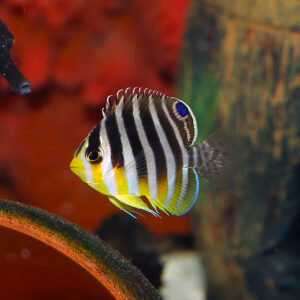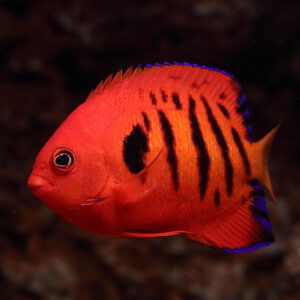Randall’s Goby, scientifically known as Amblyeleotris randalli, is a small-sized fish with a maximum length of about 3 inches (7.5 cm). It has a slender body and a distinct elongated first dorsal fin.
Natural Habitat:
In its natural habitat, Randall’s Goby is typically found in sandy or rubble areas near reef slopes or drop-offs. It seeks shelter in burrows, often created by pistol shrimp, within the sand or amongst rocks.
Keeping Randall’s Goby Healthy:
Keeping Randall’s Goby healthy requires a moderate level of care and difficulty. Providing a well-maintained aquarium with stable water parameters is essential. Tank size should be appropriate, with a minimum of 20 gallons (75 litres) to allow for swimming space and the establishment of territories.
Special Requirements and Feeding:
Randall’s Goby is a carnivorous species. It prefers a diet consisting of small meaty foods such as live or frozen brine shrimp, mysis shrimp, and finely chopped seafood. It may also accept high-quality commercial pellet or flake foods specifically designed for carnivorous fish. Feed small amounts multiple times a day.
How Many Should You Keep:
Randall’s Goby can be kept individually or in mated pairs. If keeping multiple gobies, ensure adequate space and resources to establish their territories.
Lighting Preference:
There are no specific lighting requirements for Randall’s Goby. Providing appropriate lighting for the overall reef environment is sufficient.
Suitable Tank Mates:
Randall’s Goby is peaceful and generally compatible with a wide range of tank mates, including other small fish, shrimp, and reef-safe invertebrates. However, avoid aggressive or territorial species that may pose a threat to the goby.
Symbiotic Pairing:
Randall’s Goby and Pistol Shrimp have a fascinating mutualistic relationship known as a symbiotic pairing. The relationship is facultative, meaning that it is not obligate, and both species can survive independently if separated. However, they exhibit a strong affinity for each other in the wild and often form long-term partnerships. The goby and shrimp pairing is sought after by reef aquarium enthusiasts due to their engaging behaviour and the beneficial impact on the aquarium ecosystem.
The shrimp excavates and maintains a burrow in the sand or rubble substrate, creating a complex network of tunnels. The goby takes up residence in the burrow and shares it with the shrimp. The shrimp’s burrowing activities help clean the substrate and prevent debris accumulation. The goby also contributes to the maintenance by removing excess sediment, ensuring the burrow remains clear. In exchange the goby acts as a lookout for the shrimp.
Reproduction in the Wild:
In terms of breeding, the specific details of reproduction in the wild for Randall’s Goby are not well-documented. However, like other gobies, they are believed to have an egg-laying reproductive strategy, with the male guarding and aerating the eggs until they hatch
Breeding Amblyeleotris randalli
By following appropriate tank parameters and providing suitable habitat conditions, it is possible to encourage natural reproductive behaviours in captivity.
- Setup:
To encourage breeding in Randall’s Goby, provide a well-established aquarium with stable water parameters. Create a sandy substrate with suitable burrowing areas, and include live rock or rubble for additional hiding spots. Maintain excellent water quality and ensure a stable temperature between 77°F and 82°F (25°C and 28°C).
- Courtship and Spawning:
Courtship in Randall’s Goby involves intricate displays by the male to attract the female’s attention. The male will swim near the entrance of the burrow, perform fin movements, and exhibit vibrant colours to entice the female. Once the female is receptive, they will enter the burrow together.
Inside the burrow, the male and female will engage in a spawning ritual, where the female releases her eggs, and the male fertilizes them. The male then guards and aerates the eggs, ensuring their proper development.
- Rearing Offspring:
After the eggs hatch, the larvae will enter a pelagic stage, drifting in the water column. Providing a specialized larval rearing setup is challenging and requires expertise. A separate rearing tank with appropriate water flow, temperature, and feeding protocols may be necessary to increase the chances of successfully raising the fry.
Sexual Dimorphism:
Sexual dimorphism in Randall’s Goby is not prominent. Both males and females exhibit similar body shape, coloration, and size.
Distribution:
Randall’s Goby, Amblyeleotris randalli, is native to the Western Pacific Ocean, specifically from regions such as the Philippines, Indonesia, and parts of Micronesia. It can be found in both the wild and in captive-bred populations.
Summary:
Randall’s Goby, scientifically known as Amblyeleotris randalli, is a small-sized fish with a maximum length of about 3 inches (7.5 cm). It thrives in sandy or rubble areas near reef slopes, often forming symbiotic relationships with pistol shrimp. Keeping Randall’s Goby healthy requires a moderate level of care, providing suitable tank conditions, and offering a carnivorous diet. They are peaceful and suitable for reef tanks when appropriately matched with compatible tank mates. Breeding Randall’s Goby in captivity can be challenging, but with the right setup, courtship rituals, and rearing techniques, it is possible to achieve successful reproduction. Randall’s Goby is native to the Western Pacific, including the Philippines, Indonesia, and Micronesia. Its vibrant colours and fascinating behaviour make it a popular choice for marine aquarium enthusiasts.





Reviews
There are no reviews yet.